
 : : : Drumset : : Instruments : the drums
: : : Drumset : : Instruments : the drums
The drums
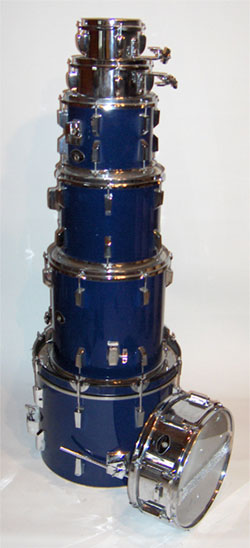
The word drum ("tambour" in French, coming from the Persian "Tabir") comes from germanic word "tromme" ("trommel" in German, probably an onomatopoeia), but we can suppose that its invention predates the first known civilizations (there are already representations in the low-reliefs of ancient Mesopotamia).
- . : General description : .
- . : The standardised sets (kits) : .
- . : Woods used : .
- . : Metals used : .
. : General Description : .
The oldest known representations are frescoes of Egyptian tombs of the XIIth Dynasty (about 2500 years before Christ). They are associated with prophane feasts and religious ceremonies (single skin drum, with stuck skin, with wood or clay shell). Assyrian representations (about 1000 years later) show single skin hand drum, closed (ogival) and with nailed skin.
The drum is generally formed of two skins stretched on either side of a cylindrical frame ("shell" or "sound box" of the drum). The Mandingo "dununs" fall therefore into this category, and certainly in its earliest form, because the shell is simply sculpted in a piece of solid wood (a tree trunk).
 European medieval drums (which are still used almost unchanged in the current brass bands, military marching bands (drum corps) and National Guard in all countries of the world with sometimes modern versions with tension bolts (United Kingdom)), are made with one or more sheets of wood arched stuck and lacquered (varnished several times) or metal (steel or brass (photo: drum of Napoleonic era, with brass shell embossed with the imperial eagle and bullet impacts!)). The tension hoops are also on wood and attached together by a rope zigzaging from a hoop to the other. Each portion of rope (or "tension rope", "tirant" ("pulling") in French) is grouped in two by a leather ring or round ("coulant" ("flowing") in French) which brings near or not by sliding the portions of rope and allows to adjust the tension. The skin is originally an asinus or calf skin, but it is now more often used a plastic skin covered with a granular treatment ("coated" synthetic skin often called "drum head" today).
European medieval drums (which are still used almost unchanged in the current brass bands, military marching bands (drum corps) and National Guard in all countries of the world with sometimes modern versions with tension bolts (United Kingdom)), are made with one or more sheets of wood arched stuck and lacquered (varnished several times) or metal (steel or brass (photo: drum of Napoleonic era, with brass shell embossed with the imperial eagle and bullet impacts!)). The tension hoops are also on wood and attached together by a rope zigzaging from a hoop to the other. Each portion of rope (or "tension rope", "tirant" ("pulling") in French) is grouped in two by a leather ring or round ("coulant" ("flowing") in French) which brings near or not by sliding the portions of rope and allows to adjust the tension. The skin is originally an asinus or calf skin, but it is now more often used a plastic skin covered with a granular treatment ("coated" synthetic skin often called "drum head" today).

The snare, this string taut against the skin below (or "resonance" or "bottom" skin or head) is a dried gut or a vegetal string, originally (like the strings of string instruments). This system, which works with the resonance in "sympathy" of the hitting (or "top") skin, which creates the unique sound of "rattle", is found on the "bendirs" large Moroccan hand tambourines. There are now steel snare wires spiraled and grouped (kind of "springs"), under the so-called "snare" ("snare drum"), which has less deep shell for a more dry and precise sound, in band, and to ease the putting on a stand for the sitting playing in modern drumset.
The european drum is traditionally played with one or two sticks of wood (in ebony with brass tip (or "butt") in military prestige drum corps and marching bands), equipped with an "olive" (French denomination: small rounded tip to ease the rebound), whose origin could be Chinese.

Used since antiquity for relaying military orders or encourage walking and "in pace" (hence the word "marches" ("walking" in French) to designate military musical compositions, which the first European battalions to use were the Swiss mercenaries (who became part of the French army since 1515, Battle of Marignano), from the fifteenth century (photo above: "Landsknechte" "peasant servants" or "mercenaries" or "lansquenets" in French (German mercenaries on the Swiss model), etching by Daniel Hopfer, 1530)), the drum also serves to rally the crowd for public statements or executions, and sometimes accompany popular festivals and parades (such as the carnival: the "mardi gras" ("fat Tuesday " in French),"spring festivities"of pagan origin). On the contrary the drums are prohibited in the churches, considered too "bestial" (violent and sensual ("dancing"), associated symbolically with the "devil" in the representations, but also with Muslims).
We must wait for the alliance with the Ottoman Turks (Francis First of France), for the use of bass drums ("davul" in Turkish, which are playing with two sticks at first (by the turks), a fine under the shell, and a thick, above), timpani and Turkish cymbals (Janissary music (see video above)) to became fashionable in European armies, and even in the court music (but rarely with all instruments combined), with modernists composers such as Lully (in France), Mozart (in Austria), Bach (in Germany) and Haydn (in England), which goes hand in hand with openness and curiosity of the "age of Enlightenment". Some troubadours (itinerant musicians of medieval courts) played the drum with one hand, and a flute with the other. At the end of the Middle Ages, beginning of mechanics, there are so-called "one-man band" that play the bass drum (big drum) using a rope attached to a foot and a beater fixed to an axis of rotation. It is the ancestor of the bass drum pedal, the first accessory that makes the american drumset a modern instrument (formerly called "batterie de jazz" ("jazz drums") in France).
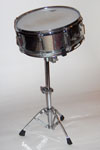
In the nineteenth century, the century of industry, Hector Berlioz, audacious French composer and conductor introduced durably the military percussions (in the Turkish type: cymbals, bass drum, small drum (snare) and timpani) in symphony orchestra to enrich the palette of timbres and provide a more expressive, illustrative popular and anecdotal music ("Symphonie fantastique" ("Fantastic Symphony"), 1830). This introduction leads naturally to an adaptation to the scene by adding drum stands (with tripod with plate for the snare, and frame with rotation axis for the bass drum to be able to play it vertically or horizontally).

Today, almost no symphonic film music happens without the military percussions to express strong accents and dramatic tension. It is no longer only to play marches, but to create sound "effects", to make link between music and natural noise, as the first cinema films, already at the time of silent film, and later with Walt Disney, who will make of the link between music (including drum set) and images, an accomplished art with Mickey Mouse, now called the "mickey-mousing" (synchronous images / film music, inspired by the Opera). It is also in the nineteenth century that is invented the tension bolt, with wing or square head screw  (the most common model today (photo)) that fit into perforated steel hoops and steel lugs screwed to the shell, or going from one tension hoop to the other (threaded at ends rods and nuts (system still used for Brazilian drums: "repinique", "surdo", "caixa" (or "tarol ": designates a single tightening snare), "cuica, etc.).
(the most common model today (photo)) that fit into perforated steel hoops and steel lugs screwed to the shell, or going from one tension hoop to the other (threaded at ends rods and nuts (system still used for Brazilian drums: "repinique", "surdo", "caixa" (or "tarol ": designates a single tightening snare), "cuica, etc.).
With the jazz drum set in the early twentieth century, it is on a whole group of different drums that a single drummer plays ("drumset" or "drumkit").
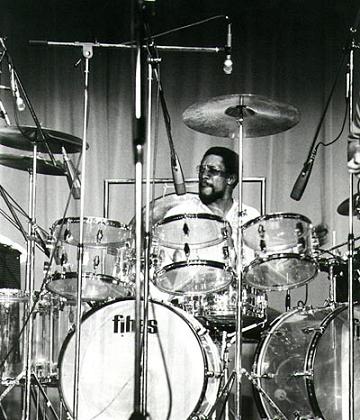 In the 1970s, some drummers (like Billy Cobham (Mahavishnu Orchestra (photo)) or John Bonham (Led Zeppelin)) use new drums with plastic shells (transparent), with a more "clear" sound and a more "futuristic" aesthetic (especially if you put light "spots" below).
In the 1970s, some drummers (like Billy Cobham (Mahavishnu Orchestra (photo)) or John Bonham (Led Zeppelin)) use new drums with plastic shells (transparent), with a more "clear" sound and a more "futuristic" aesthetic (especially if you put light "spots" below).
In the 1980s, the electronic age, drums with electronic sensors (usually in rubber) are commercialized, which are connected to a computer-base transmitting synthesized or recorded sounds with amplifiers (speakers or headphones, to train silently).
But the lack of expressiveness of sounds and gestures resulting from this system, makes that the current drummers still prefer to use acoustic wooden or metal drums, even amplifiyng by the microphones (like guitars, for example, with a microphone isolated per drum).

. : The standard sets (kits) : .
For "rock" (louder):
- A bass drum 22 "diameter (1"=1 inch = 2.54 cm)
- A snare drum 14 "
- A suspended tom 12 "
- A suspended tom 13 "
- A "floor" tom (or "bass tom") 16 "
For jazz (or "Jazzette" drumset, smaller, for "cabaret", jazz club):
- Bass Drum: 18 "
- Snare: 14 or 13 "
- Toms 10, 12 (sometimes only 12) and 14 "
For fusion ("jazz-rock", intermediate):
- Bass Drum: 20 "
- Snare: 14 "
- Toms 10, 12, 14 "
Some models of some brands even offer often an accessory kit and more (bass drum pedal, hi-hat pedal, even a suspended cymbal). Others do not include the snare drum, which is often more personalized among drummers. Some brands now offer complete kits with more original sizes and configurations, including four or five toms, which is quite common in standard jazz fusion, progressive rock and heavy metal since the 1970s, but up to now obliged to manufacture and customize on demand (very expensive and long).
To help you to build an original drum set, see my lesson: "Conceiving your drum set".

. : Woods used for the shells : .
- Maple:
- Surely the noblest and "flamboyant" (but also much more expensive, wood traditionally used for European classical violins), with the most rich, round and resonant sound, while maintaining a very precise and dry attack (more than metal), which gives a natural balance. The absolute standard for drumset used by all great drummers in history, in all styles of music. The richness of its timbre and elasticity confer chaotic vibrations quite difficult to control (it sometimes disrupts rebounds and highlights any dynamic difference), it's why many great drummers prefer metal snares, the instrument on which we do the most of rolls in modern drumset playing.
- Birch:
- More elastic and less dense than maple, it emphasizes contrast and attack ("explosive" hyper-expressive sound, even more difficult to control than maple, used traditionally for Russian balalaikas). Birch is apreciated by some jazz and metal drummers, who seek to "surprise" (in every sense of the term).
- The mix of the two previous (one birch ply for one maple ply):
- More neutral and less powerful sound, both woods annihilating their characteristics of roundness and brightness but still gaining richness of tones (but more "untidy", like a "mixed" wine, less harmonious).
- Mahogany:
- Close to Maple but drier (less resonant), and with softer attack, with many low and medium overtones and tonics quite accurate, and therefore more controllable (mahogany wood is quite dense (hard and heavy) but still elastic, used for traditional West African djembes and balafons (kind of xylophones, with very pure and precise tones), notably). It is now a protected species and therefore rare.
- Oak:
- Traditionally used for Cuban congas (on the model of French wine barrels), oak is quite a hard wood but generally softer than exotic red mahogany, very accurate in tone and dry but still bright and resonant, and with a lot of bass overtones. This is a wood introduced very recently for modern drumset.
- Beech:
- Newly introduced successfully (chosen by the Japanese soloist drummer Akira Jimbo ), even drier than mahogany and oak (recommended for those who play very fast).
- Linden (basswood):
- Used generally to "blend" with the noblest woods mentioned above, in the low-end drumsets. Poor and felted sound, remove power, precision of attack, resonance and harmony. Not recommended for the stage or with subtle skin and microphone adjustment, amplifying the resonance (but will then decrease the clarity and rebound).
- Poplar:
- Idem even less dense and elastic.
NB: be careful: all of these wood qualities also rely heavily on wood varieties used, climate of origin and even each tree, its processing and manufacturing, so I can't recommend you enough to try the drumsets and compare them before to buy one.
- About pressed wood ("agglomerate"):
- Material that gives a sound so poor, ugly, weak and less expressive than almost no current brand does now offers it (I don't recommend it whatever use).
Finishes: all these woods can be painted with varying layers of varnish (the more layers there are, the more we gain in clarity and resonance), with color or not, if not downright painted (is less, impoverished sound, ugliest visually) or just sanded and covered with a plastic film (low end drumsets).
Video showing the current process of industrial production of wooden drums for modern drumset, from the forest to the workshop of Drum Workshop Inc. (DW Drums, USA).

. : Metals used for the shells (generally for snare drums only) : .
- The chrome steel (stainless steel ("inox")):
- Bright sound, quite "blur" in attack, and very powerful, with a very definite fundamental tone (very pure, often unappreciated) and a timbre quite rich but not complex. Many steel drum snare are "folded" in the center (since 1914, Ludwig brand, first industrial manufacturer of modern drumset (bass drum pedal in 1910) also the first manufacturer to make 100% metal snares in 1911). This makes the sound more "dull" and "dry", and enriches the timbre (it "breaks" the vibrations and reduces excessive definition of the fundamental tone, but reduces the contrast (amplitude of dynamics), the resonance and power).
- Copper (pure (red-orange) or with zinc alloy (yellow, "brass" or "gunmetal")):
-
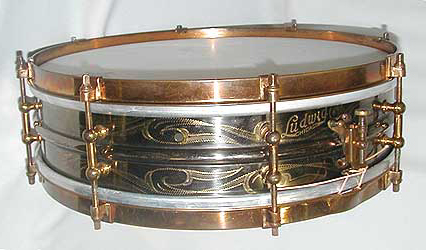 You have just to heard a trumpet to be convinced of the extreme qualities of sound resonance of copper. Material already and still used for drums in the army (it protected from bullets and had an excellent sound projection), and classical timpani, it made the celebrity of the Ludwig "De Luxe" snare model (later called "Black Beauty", anodized (plated) black nickel and also engraved with decorations at the origin) since 1920 (photo), and is commonly used for luxury Latin timbales models. Brighter than steel, copper (or brass) also had a more "complex" sound (harmonious, and therefore enjoyable) than steel, while still nearest than wood, with lots of high and super high overtones (which gives an attack clearer and faster ("dry" and expressive), also nearest from wood). It is obviously more expensive than steel (and attention, more fragile).
You have just to heard a trumpet to be convinced of the extreme qualities of sound resonance of copper. Material already and still used for drums in the army (it protected from bullets and had an excellent sound projection), and classical timpani, it made the celebrity of the Ludwig "De Luxe" snare model (later called "Black Beauty", anodized (plated) black nickel and also engraved with decorations at the origin) since 1920 (photo), and is commonly used for luxury Latin timbales models. Brighter than steel, copper (or brass) also had a more "complex" sound (harmonious, and therefore enjoyable) than steel, while still nearest than wood, with lots of high and super high overtones (which gives an attack clearer and faster ("dry" and expressive), also nearest from wood). It is obviously more expensive than steel (and attention, more fragile).
- Aluminum:
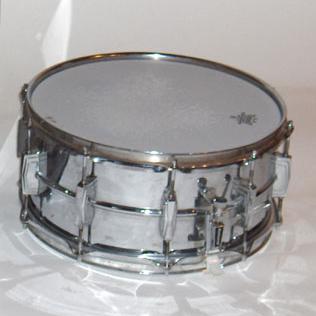 Rare material for snares and generally used for Brazilian percussions (for its lightness, because it is to march for hours during carnivals), it made the fame of "Supraphonic" (model created in 1963 all chrome plated, molded shell (seamless), folded at the center, two rows of 10 tension rods (for an hyper tight (subtle, fine) and stable skins tension adjustment) with adjustable internal felt damper and finally ten "embellishing" lugs ("Imperial Lug "created in 1936), which received the pairs of opposite tension rods) from American brand Ludwig (which was my favorite snare with Aquarela, but also that of John Bonham (Led Zeppelin), Hal Blaine (Elvis Presley), Mitch Mitchell (Jimi Hendrix), Steve Gadd (Paul Simon, Chick Corea, Michel Petrucciani, Bee Gees, Chet Baker, Eric Clapton, George Benson, Ray Barretto , Al Jarreau, Ray Charles, ...), Charlie Watts (Rolling Stones), Ringo Starr (Beatles), Joe Morello (Dave Brubeck) and Buddy Rich among others (considered as the snare model the most recorded in history: "no comment!"): the "Rolls Royce" of snare drums, without doubt for its perfect balance between power, harmonic complexity (but not too much) highlighting the mid-high overtones of the snare, its regularity and sound control (especially thanks to its adjustable damper), with a very soft attack which contrasts perfectly the rim shots with the ghost notes: a snare ideally made for the man hand in my opinion (photo: Ludwig Supra-phonic LM402, 14x6.5 "model created in 1971)). In general, aluminum was chosen by the Brazilian carnival percussionists also for its clear, pure, contrasted and powerful sound, without being too "staccato" (dry, unlike wood), justified outside, acoustics, to hear the call "rim shots" of the chief repinique or tuned notes of the surdos.
Rare material for snares and generally used for Brazilian percussions (for its lightness, because it is to march for hours during carnivals), it made the fame of "Supraphonic" (model created in 1963 all chrome plated, molded shell (seamless), folded at the center, two rows of 10 tension rods (for an hyper tight (subtle, fine) and stable skins tension adjustment) with adjustable internal felt damper and finally ten "embellishing" lugs ("Imperial Lug "created in 1936), which received the pairs of opposite tension rods) from American brand Ludwig (which was my favorite snare with Aquarela, but also that of John Bonham (Led Zeppelin), Hal Blaine (Elvis Presley), Mitch Mitchell (Jimi Hendrix), Steve Gadd (Paul Simon, Chick Corea, Michel Petrucciani, Bee Gees, Chet Baker, Eric Clapton, George Benson, Ray Barretto , Al Jarreau, Ray Charles, ...), Charlie Watts (Rolling Stones), Ringo Starr (Beatles), Joe Morello (Dave Brubeck) and Buddy Rich among others (considered as the snare model the most recorded in history: "no comment!"): the "Rolls Royce" of snare drums, without doubt for its perfect balance between power, harmonic complexity (but not too much) highlighting the mid-high overtones of the snare, its regularity and sound control (especially thanks to its adjustable damper), with a very soft attack which contrasts perfectly the rim shots with the ghost notes: a snare ideally made for the man hand in my opinion (photo: Ludwig Supra-phonic LM402, 14x6.5 "model created in 1971)). In general, aluminum was chosen by the Brazilian carnival percussionists also for its clear, pure, contrasted and powerful sound, without being too "staccato" (dry, unlike wood), justified outside, acoustics, to hear the call "rim shots" of the chief repinique or tuned notes of the surdos.
- Bronze (copper + tin alloy):
- Newly used by some brands (probably inspired by the cymbals), bronze brings warm richness of tone that is lacking in pure metals, as well as greater dryness and shine (but less than pure copper or brass), without altering the power (to try).

Some brands also offer recently hammered metal drum shells (battered), in imitation of the cymbals, which enriches and drys their sound even more.
Marc De Douvan Dec. 2005, revised and translated in English in March 2013
Indicative sources and for more information: website showing vintage catalogs and pictures and photos of old modern drumsets: www.vintagedrumguide.com
© 2005 Marc de Douvan Crédits Mentions légales
